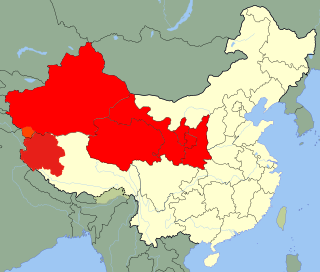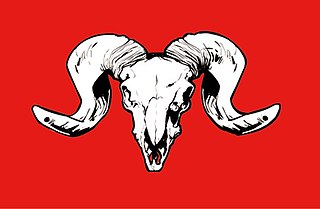Related Research Articles

Airborne forces, airborne troops, or airborne infantry are ground combat units carried by aircraft and airdropped into battle zones, typically by parachute drop or air assault. Parachute-qualified infantry and support personnel serving in airborne units are also known as paratroopers.

The 101st Airborne Division is a light infantry division of the United States Army that specializes in air assault operations. It can plan, coordinate, and execute multiple battalion-size air assault operations to seize terrain. These operations can be conducted by mobile teams covering large distances, fighting behind enemy lines, and working in austere environments with limited or degraded infrastructure. Its unique battlefield mobility and high level of training have kept it in the vanguard of U.S. land combat forces in recent conflicts: for example, foreign internal defense and counterterrorism operations in Iraq, in Afghanistan in 2015–2016, and in Syria, as part of Operation Inherent Resolve in 2018–2021.
A division is a large military unit or formation, usually consisting of between 6,000 and 25,000 soldiers.
The London Regiment was an infantry regiment in the British Army, part of the Territorial Force. The regiment saw distinguished service in the First World War and was disbanded in 1938, shortly before the Second World War, when most of its battalions were converted to other roles or transferred elsewhere. The lineage of some of its former battalions is continued by the current regiment of the same name.

The 15th Infantry Brigade, later 15 Brigade, was an infantry brigade of the British Army. It was part of the regular 5th Infantry Division during the First World War and Second World War, and was subsequently part of the 2nd Infantry Division in the north of the United Kingdom, with specific responsibility for the areas of North East England and Yorkshire and the Humber.

The Korean People's Army Air and Anti-Air Force is the unified military aviation force of North Korea. It is the second largest branch of the Korean People's Army comprising an estimated 110,000 members. It possesses around 950 aircraft of different types, mostly of decades-old Soviet and Chinese origin. Its primary task is to defend North Korean airspace.

The Lanzhou Military Region was one of seven military regions in the People's Republic of China. It directed all People's Liberation Army and People's Armed Police forces in Xinjiang, Qinghai, Gansu, Ningxia, Shaanxi, and Ngari Prefecture in northwest Tibet. It was headquartered in Lanzhou in Gansu Province. It is bordered to the south by the Chengdu Military Region, and to the north by Mongolia, the Altai Republic, which is a political subdivision of the Russian Federation, and Kazakhstan. This region is now part of the Western Theater Command due to the military reforms of 2015.

The Romanian Air Force 57th Air Base "Mihail Kogălniceanu" is an air base located near Constanța, at the Mihail Kogălniceanu International Airport. It is currently home to the 572nd Helicopter Squadron and also hosts the 861st Fighter Squadron of the 86th Air Base. The current base commander is Comandor Nicolae Crețu, succeeding Comandor Adrian Popescu.
The 39th Separate Order of the Red Banner Motor Rifle Brigade is a mechanized infantry brigade in the Russian Ground Forces. Originally formed as the Blagoveshchensk Fortified Region of the Soviet Union's Red Army in 1932, it became the basis for the 2nd formation of the 342nd Rifle Division and took part in the Soviet invasion of Manchuria. During the Cold War, it was reformed as the 56th Motor Rifle Division and later re-designated as the 33rd Separate Motor Rifle Division. In 2009, it was downsized and reorganized into the 39th Separate Motor Rifle Brigade as part of the 2008 Russian military reform.

The 3rd Cavalry Division "Principe Amedeo Duca d'Aosta" was a Cavalry or "Celere" (Fast) division of the Royal Italian Army during World War II. The division was formed in 1934, and during World War II was mobilized in June 1940. As a cavalry division it took part in the Invasion of Yugoslavia and was part of the Italian Expeditionary Corps in Russia. Annihilated during the Red Army's Operation Little Saturn in December 1942, the survivors returned to Italy in spring 1943.

The 242nd Training Centre of the Airborne Forces is a brigade-sized training formation of the Russian Airborne Troops.
The 14th Rifle Division was an infantry division of the Red Army, formed twice. Formed in Moscow in 1922, the division spent most of the interwar period at Vladimir. After moving to the Kola Peninsula during the Winter War, the division fought on that front during the Continuation War. After the end of the Continuation War it became the 101st Guards Rifle Division. The division reformed in 1955 from the 180th Rifle Division but became the 88th Motor Rifle Division in 1957.

The 58th Division was an infantry division created in 1915 as part of the massive expansion of the British Army during the First World War. It was a 2nd Line Territorial Force formation raised as a duplicate of the 56th Division. After training in Britain, the division joined the British Expeditionary Force (BEF) on the Western Front in 1917. It saw action at the battles of Arras and Passchedaele in 1917 and the German spring offensive in 1918. It then took part in the Battle of Amiens and the final Allied Hundred Days Offensive of the war. The division was recreated during the Second World War, as an imaginary deception formation.
The Northern Army Group (NORTHAG) was a NATO military formation comprising five Army Corps from five NATO member nations. During the Cold War NORTHAG was NATO's forward defence in the Northern half of the Federal Republic of Germany (FRG). The Southern half of the Federal Republic of Germany was to be defended by the four Army Corps of NATO's Central Army Group (CENTAG). During wartime NORTHAG would command four frontline corps and one reserve corps. Air support was provided by Second Allied Tactical Air Force.

The 1st Artillery Brigade was a support formation of the British Army as part of the 3rd Division, and oversaw all close support artillery and deep fires units of the army. Under the Future Soldier programme, the brigade merged with 1st Armoured Infantry Brigade to form 1st Deep Recce Strike Brigade Combat Team.
The 34th Rifle Division was an infantry division of the Red Army during and before World War II. The division was formed in 1923. It fought in the Soviet invasion of Manchuria in August 1945. Postwar, it became the 11th Machine Gun Artillery Division.
The 111th Tank Division was a Tank division of the Soviet Union's Red Army and after 1946, the Soviet Army. The division was formed in the summer of 1941 in the Soviet Far East from the tank regiment of a motorized division that had been reorganized into a motor rifle division, and had thus lost its tank regiment. The division never fought in combat and was in reserve during the Soviet invasion of Manchuria. Postwar, the division continued its garrison duty in the Far East. The 111th was renumbered as the 16th Tank Division in 1955.
The Fourteenth Fighter Division is a Fighter aircraft unit of the Chinese People's Liberation Army Air Force (PLAAF).
The 4th Aviation Division is a formation of the Chinese People's Liberation Army Air Force (PLAAF). Initially established in 1950, it served in Korea under Commander Fang Ziyi and Commissar Ye Songsheng, flying Mikoyan-Gurevich MiG-15s. It ended its third combat tour in July 1953. It was soon redesignated the 1st Fighter Division.
References
- ↑ "Orbats - Scramble". www.scramble.nl. Archived from the original on 8 September 2017. Retrieved 2 September 2020.